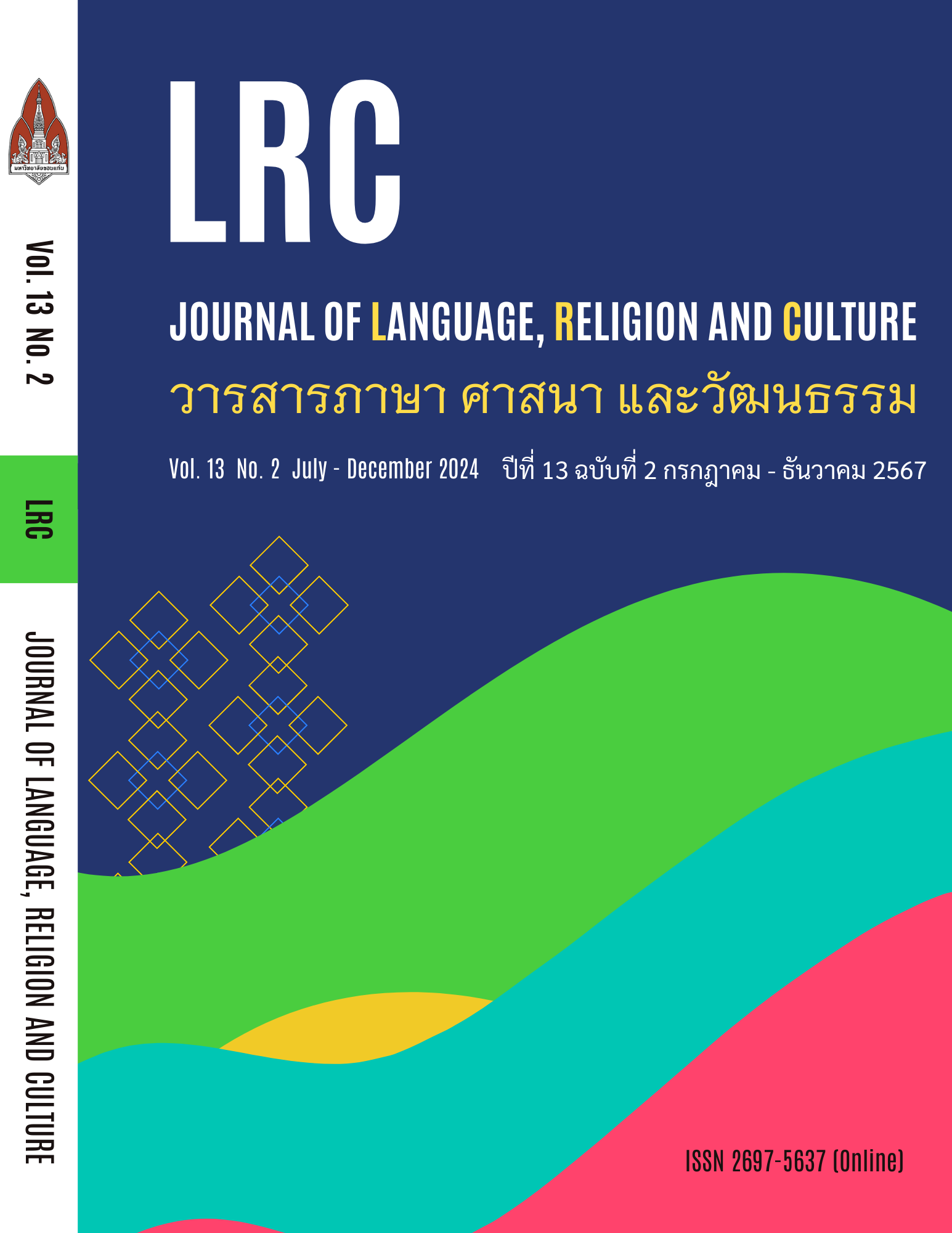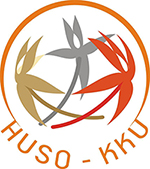อุปลักษณ์ผู้หญิงในตำนานสร้างโลกของกลุ่มชนชาติไทและชนชาติจ้วง
อุปลักษณ์ผู้หญิงในตำนานสร้างโลกของกลุ่มชนชาติไทและชนชาติจ้วง
คำสำคัญ:
อุปลักษณ์ผู้หญิง, ตำนานสร้างโลก, ชนชาติไท, ชนชาติจ้วง, สตรีนิยมนิเวศบทคัดย่อ
อุปลักษณ์ผู้หญิงในตำนานสร้างโลกของกลุ่มชนชาติไทและชนชาติจ้วง เป็นงานวิจัยเชิงคุณภาพ มีวัตถุประสงค์เพื่อศึกษา และวิเคราะห์อุปลักษณ์ผู้หญิงในตำนานสร้างโลกของกลุ่มชนชาติไทและชนชาติจ้วงจำนวน 12 สำนวน ได้แก่ สำนวนกลุ่มชาติไทซึงประกอบด้วยไทยวน 1 สำนวน ไทยภาคอีสาน 2 สำนวน ไท สปป.ลาว 1 สำนวน ไทประเทศเมียนมา 1 สำนวน ไทใหญ่สิบสองปันนายูนนานประเทศจีน 1 สำนวน และสำนวนของชนชาติจ้วง 6 สำนวน โดยใช้ทฤษฎีสตรีนิยมนิเวศ
ผลการศึกษาอุปลักษณ์ผู้หญิงพบว่า ตำนานสร้างโลกที่มีผู้หญิงสร้างโลกของชนชาติไทได้อุปลักษณ์ผู้หญิงทั้งหมด 7 ประการ ได้แก่ สัตว์ ภูเขา แผ่นดิน สิ่งเหนือธรรมชาติ ธาตุดิน น้ำ และแสง ตำนานสร้างโลกที่มีผู้หญิงสร้างโลกของชนชาติจ้วงได้อุปลักษณ์ผู้หญิงทั้งหมด 6 ประการ ได้แก่ ดอกไม้สีแดง มะเฟือง สิ่งเหนือธรรมชาติ ดินหรือพื้นดิน แสงพระจันทร์ และถ้ำหิน ผลการวิเคราะห์อุปลักษณ์ผู้หญิงเชิงสตรีนิยมนิเวศของชนชาติไทคือ สะท้อนผู้หญิงชนชาติไทกับธรรมชาติว่ามีความใกล้ชิดกัน และสะท้อนการแปรเปลี่ยนทางสังคมของสถานะผู้หญิง ซึ่งมีทั้งผู้หญิงที่ต่ำด้อยกว่าผู้ชาย หญิงชายเสมอภาคกัน และผู้หญิงอยู่ตำแหน่งรอง นอกจากนี้ยังสร้างภาพลักษณ์ให้หญิงชนชาติไทเป็นผู้ที่มีีความอดทน เสียสละ กล้าหาญ ฉลาดเฉลียว ผลการวิเคราะห์อุปลักษณ์ผู้หญิงเชิงสตรีนิยมนิเวศของชนชาติจ้วงคือ ผู้หญิงชนชาติจ้วงกับธรรมชาติมีความเป็นหนึ่งเดียวกัน ธรรมชาติกับมนุษย์สามารถอยู่ร่วมกันอย่างสันติ และสะท้อนให้เห็นถึงสถานะผู้หญิงชนชาติจ้วงที่ผลัดเปลี่ยน ซึ่งเสื่อมถอยจากสูงส่งมาสูู่่ตำแหน่งรองของผู้ชาย แล้วกลายเป็นชายหญิงเสมอภาค และสร้างภาพลักษณ์ให้ผู้หญิงชนชาติจ้วงมีความเมตตา เสียสละ กล้าหาญ ฉลาดเฉลียว ขยันหมั่นเพียร และอ่อนโยน
เอกสารอ้างอิง
Arne, N. (2017). The Shallow and the deep, long-range ecology Movement: A summary. The Ethics of the Environment.
Ath Ditisood. (2020). "Mother" and Nature in Globalization Literature:Ecofeminism Viewpoint. Aksara Pibul Journal,1(2), 10.
Bo Saeng Khamwongdara and group. (1987). (Lao PDR). Lao literature. Vientiane: Ministry of Education, Social Science Research Institute.
Chatchawadee Saralamba. (2005). Metaphor in Cognitive Linguistics Theory. Journal of Liberal Arts, 5(1), 2.
Encyclopedia of Thai Culture Foundation, T. C. B. (1999). Encyclopedia of Northeastern Thai culture. Bangkok:Encyclopedia of Thai Culture Foundation, Thai Commercial Bank.
Fan, H. (2013). The same Root Nation. NanNing: Guangxi People's Publishing Press.
He, Z. (2009). Analysis of the Evolutionof Muliujia the Genesis Goddess of Zhuang Nationality into Huapo Flower Goddess of Fertility. Journal of Liuzhou Teachers College, 24(5), 7.
Phatthamon Hongsuwan. (2013). Long ago: there were stories, tales, legends of life. Bangkok: Chulalongkorn University Book Center Press.
Huang, L. (1996). Zhuang Goddess: The Historical Accumulation of Primitive Worship and Folk Culture. Journal of Youjiang Teacher’ College for Nationalitles, 9(1), 37-43.
Lakoff, & Johnson. (1980). Metaphors We Live By. Chicago: Univercity of Chicagou Press.
Lan, H. (2004). Lan Hong'en Anthology·Story Volumes. Editorial Board of Lan Hongen's Anthology. NanNing: Guangxi Nationalities Publishing House.
Nong, P. (2007). Zhuang Mythology Integration. NanNing: Guangxi Nationalities Publishing House.
Nong P. Nong Pingguan and group. (1992). Goddess·Song Immortal·Hero-A new selection of Zhuang Folk Tales. NanNing: Guangxi Nationalities Publishing House.
OUMAN. (2017). The Creation Myths of the Tai-Zhuang Peoples : The Worldviews, Beliefs and Rituals. Ph.D. Thesis in Thai Studies, Faculty of Humanities and Social Sciences, Burapha University.
Palita Phonpradapphet. (2017). Emotion Metaphors in Thai. Wiwitwannasan.1(1); 65.
Phra Thammathatto Bhikkhu P. Na Pramuanmark. (1990). he Legend of the Thai Ghost Tree. Bangkok: Kled Thai.
Pinanong Ampala. (2019). Conceptual metaphor TIME IS MOTION "DOWN" in Northern Thai Dialect. Princess of Naradhiwas University Journal of Jumanities and Social Sciences,7(1), 47.
Siraporn Na Thalang. (1996). An analysis of the creation myths of the Tai speaking peoples. N. S. T. O. University.
Sirisira Chokthawikit. (2021). Conceptual Metaphor of [FEAR] in Literary Work: A Case Study of the Short Story Entitled Confused Calmness in Snakes’ Wilderness. Journal of Studies in the Field of Humanities, 28(1), 132.
Tharapanya Publishing. (1996). Old Tales. Chiang Mai: Tharapanya.
Thepporn Mungthanee. (2013). The Environmental Ethics of Culture in Mekong Region: A Case Study of Thai-Lao Culture in Mukdaharn Province. Journal of Mekong Societies. 9(3), 57-76.
Waen Pleng-or. (1976). With wisdom and love, stories of the northern people. Bangkok: Social Science Association of Thailand.
Shu, D. (2000). Studies in Metaphor. Shanghai: Shanghai Foreign Language Education Press.
Wang, H. (2019). Ecofeminist Studies. Harbin: Harbin Engineering University Press.
Zhou, D. (2022). The "Line" of Heaven has the Exploration of the Five Elements of Yin and Yang. Beijing:Solidarity Press.
ดาวน์โหลด
เผยแพร่แล้ว
รูปแบบการอ้างอิง
ฉบับ
ประเภทบทความ
สัญญาอนุญาต
ลิขสิทธิ์ (c) 2024 วารสารภาษา ศาสนา และวัฒนธรรม

อนุญาตภายใต้เงื่อนไข Creative Commons Attribution-NonCommercial-NoDerivatives 4.0 International License.







